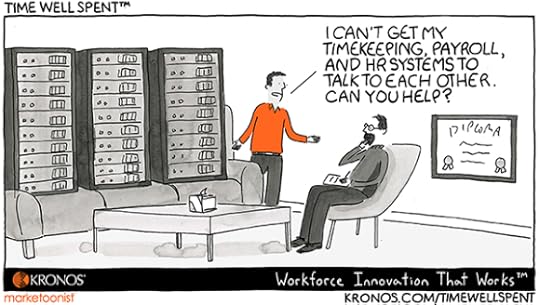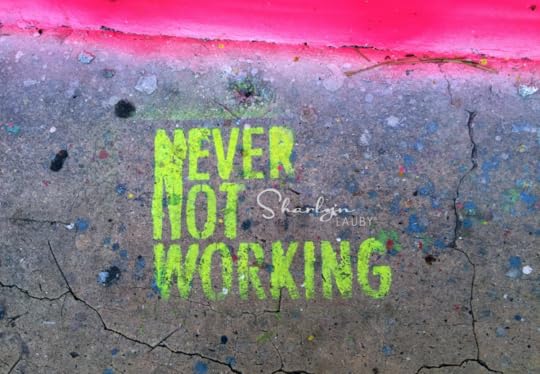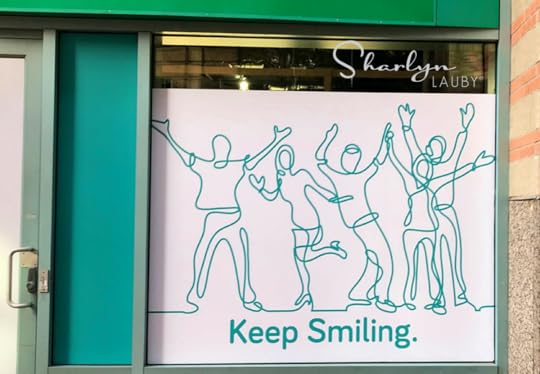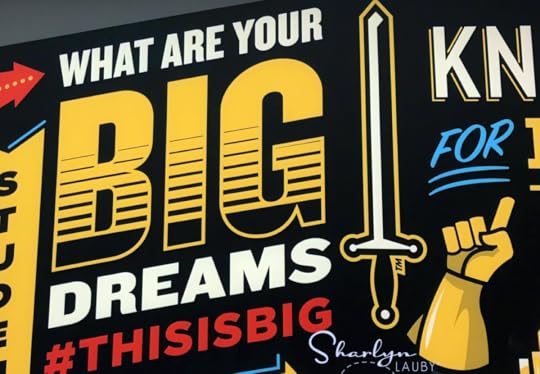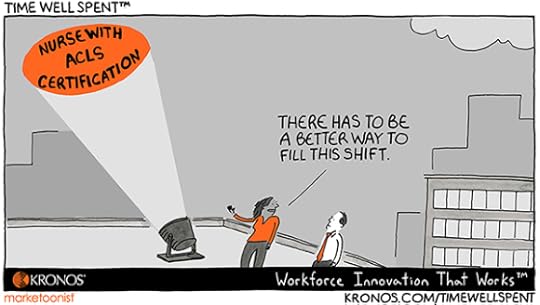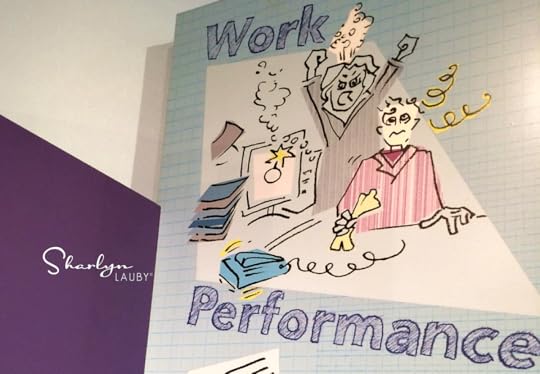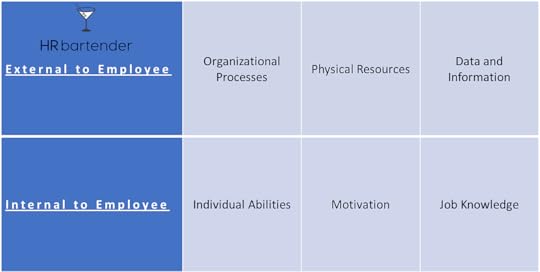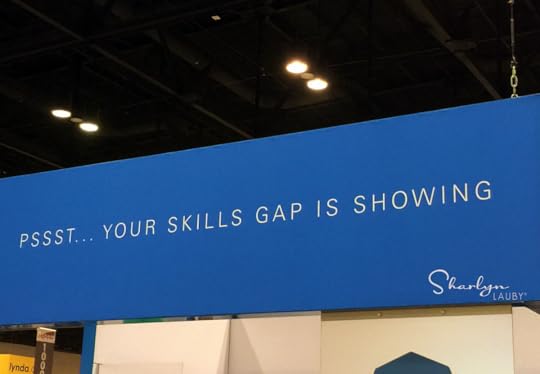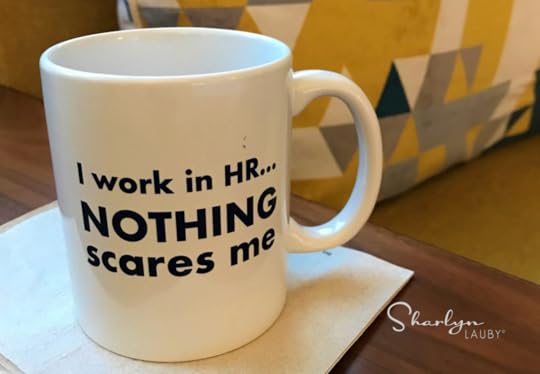Sharlyn J. Lauby's Blog, page 113
August 17, 2018
Align Technology For Maximum Effectiveness and Efficiency – Friday Distraction
(Editor’s Note: Today’s post is brought to you by our friends at Kronos , a leading provider of workforce management and human capital management cloud solutions. They were recently in separate competitions in Asia, Canada, India, and the U.K. Congrats to them and enjoy the article!)
Mr. Bartender and I have an Amazon Alexa in our home. One of the things we love about the device is its compatibility. We can connect lightbulbs, security cameras, etc. to the device for maximum efficiency. We can get those little “dot” devices and play music around the house. You get the point. The system is very compatible with other stuff in our lives.
I couldn’t help but be reminded about the importance of compatibility when I saw this Time Well Spent cartoon from our friends at Kronos. It’s important to align our technology devices and systems to get the most out of them.
The good news is … that doesn’t mean we have to purchase all of our tech from one source. Technology providers are working together, creating strategic partnerships, and using the Internet of Things (IoT) to benefit users.
When making purchasing decisions about technology, ask about compatibility. Don’t assume that devices are compatible, they might not be. The reverse is equally true. Don’t assume that the devices won’t be compatible, it’s possible they could be. Get good information by asking questions and doing your homework. Vendors are accustomed to answering these types of questions and, if they don’t know the answer, they’ll help you get one.
Stay current with new technology developments. Speaking of doing your homework, technology is changing all the time, which means compatibility is changing as well. Devices that couldn’t speak to each other last year, might be able to now. Find ways to stay up-to-date on software updates by subscribing to technology blogs, electronic newsletters, etc. so you know what’s coming and can take full advantage of updates.
Regularly evaluate the return on investment. One of the things that I’ve learned with my own personal technology is there are times when I realize how much I’ve invested in an ecosystem. Using my Alexa as an example, if I have a bunch of compatible add-ons, I might be reluctant to buy a Google Home or Apple HomePod because I’d have to start over. It’s important to evaluate future technology investments with this in mind.
One of the advantages technology can bring us is alignment with our other devices. Whether it’s on a personal level or our organization’s technology systems. But it takes coordination. Doing our homework on the front end eliminates surprises during implementation. Staying current allows us to take advantage of updates. And constantly monitoring our investment keeps the company effective and efficient. Which is why we’re using technology in the first place!
The post Align Technology For Maximum Effectiveness and Efficiency – Friday Distraction appeared first on hr bartender.






August 14, 2018
4 Reasons Why Organizations Should Focus on Performance
Some of you might be thinking, doesn’t every organization focus on performance? Well, I think the answer to that is … maybe.
I know in my career, I’ve worked for companies that spent a huge amount of time focused on goals, only to abandon all of them for some shiny new program. I’ve also worked in situations where achieving the result was the most important thing … and it didn’t matter who was hurt along the way. If you haven’t worked for an organization where this was the culture, it’s possible that a manager or just a department adopted that philosophy.
When I think about it, performance involves both the results and the methods used to achieve those results. And that’s why organizations should focus on performance, because it’s just as much about the pre- and the post- as it is the actions itself. There are four reasons for organizations to focus their efforts on performance:
It creates a way for organizations, departments, and individuals to plan activities. I’m intentionally not saying goals here because performance doesn’t always have a direct goal attached to it. That being said, our performance of small tasks can have a huge impact on goals. It requires some thought and intention at every level.
By focusing on performance, everyone stays on track. This ties a little bit into reason number one above. Regardless of the task or activity we’re asked to perform, we need to do it well. And we should want to do it to the best of our ability. The company is focused on hiring candidates who can perform, training them to perform at their best.
Performance allows for the logical flow of information to stakeholders. When companies focus on performance, then that’s what they talk about during meetings, feedback sessions, and coaching conversations.
It permits organizations to gauge their progress. This is where I think goals and benchmarks might factor into the conversation. When companies are focused on performance, they will want to have some sense of how well they’re performing. This can be reported to stakeholders (see reason #3) and possibly, prompt new direction (see #2).
The business world is very complex and we all have a tremendous amount of data and information to curate each day. By staying focused on performance … from an individual, team, and organizational perspective, it can help us create a filtering system. Do I need this information to perform better? Would this program help the team perform faster? Could this new process allow the organization to perform at the same level of quality while reducing costs? You see the point.
But make no mistake, focusing on performance is hard. If it were easy, everyone would be doing it. It’s easy to get distracted. And when we get too distracted, it’s a challenge to get it back on track. It can be done though, with some honest conversation and a tremendous amount of cultural willpower.
Image captured by Sharlyn Lauby while exploring the Wynwood Art District in Miami, FL
The post 4 Reasons Why Organizations Should Focus on Performance appeared first on hr bartender.






August 12, 2018
Employee Engagement Is a Financial Strategy
We spend a lot of time talking about creating employee engagement. The rationale being that engaged employees are highly productive. And productivity fuels the business.
In creating employee engagement, we need to think about employee satisfaction. I don’t see how a dissatisfied employee becomes engaged. It seems like their dissatisfaction with the company, their manager, their work, etc. is a barrier to engagement. On the other hand, employees who are satisfied with their organization, team, manager, work, etc. have opened the door to engagement. While it’s not a guarantee, they’re one step closer than the dissatisfied employee.
So, the question becomes, how do organizations achieve employee satisfaction? According to Jacob Morgan’s book “Employee Experience Advantage”, it’s about creating an outstanding employee experience. His research indicates companies that invest in the employee experience are four times as profitable as those that don’t and have more than two times the average revenue.
This research is supported in the Globoforce white paper “The Financial Impact of a Positive Employee Experience.” Their research reported that organizations that score in the top 25 percent on employee experience have nearly three times the return on assets compared to organizations at the bottom of the list.
My takeaway from these two pieces is that companies making investments in employee experience and engagement are doing so for more than feel-good feedback. The employee experience and employee engagement are key components of the company’s financial strategy. And senior managers not only need to thinkabout it that way but talkabout it that way.
For a moment, think about the other components of your organization’s financial strategy. Or your own personal financial strategy for that matter. It probably includes things like sticking to a budget, making investments in the future, and having an emergency fund. These are excellent strategies whether you’re a global corporation, small business, or an individual. And they are about more than money.
Organizations need to create compensation and benefit programs that are internally fair and externally competitive. The conversation about employee satisfaction and engagement isn’t about throwing money at employees. It’s about delivering value.
Companies should invest in employee’s futures with training and development opportunities. Employees want to know they have a career with the company. They want to know that managers support their career goals. Companies need to set aside a budget for employee development.
Finally, organizations need to realize that sometimes stuff just happens. And they have to spend money they didn’t budget. Sometimes organizations need to open their wallets and do the right thing like buy an employee a nice office chair when theirs breaks. Or have a celebration when they score a big account.
Years ago, there was this trend to rename human resources as human capital because “employees are the company’s greatest asset”. Some people balked at the idea saying that employees aren’t assets because … well, they’re human. In this case, we’re not saying that employees are the same as furniture, fixtures, and equipment. Because they’re not.
But employee satisfaction and employee engagement have value. Measurable financial value. And organizations need to recognize that … or they run the risk of leaving money on the table.
Image captured by Sharlyn Lauby while exploring the streets of Boston, MA
The post Employee Engagement Is a Financial Strategy appeared first on hr bartender.






August 10, 2018
Bookmark This! Content Curation Edition
A few years ago, I was introduced to the concept of curation. It’s when information is gathered relevant to a particular topic or interest. Curation can be provided by individuals. For example, some could say that this issue of “Bookmark This!” is curated around the subject of curation.
Curation can also be provided by companies. For example, there’s a lot of curated newsletters popping up like The Skimm, Morning Brew, and NextDraft. These are sites that read the news for you and present it in small, easy to digest formats. The idea being if you like the writing style and the topics they cover, then you’ll subscribe. And, if you see something interesting, then you can dig deeper into the topic.
I’ve been seeing a lot of conversation lately about the concept of curating information and the value it can bring individuals and organizations. Specifically, how teaching employees the concept of curation can be a part of a company’s informal and social learning strategy.
All of this talk about curation reminds me of a series I read years ago on the subject. Written by Robin Good, the series went into great depth about real-time news curation. I went back and reread the entire series to see if the series has withstood the test of time. And I must admit, even though it was published originally in 2010, the high-level concepts still hold true today. So, I wanted to share the links with you.
Part 1: Why We Need Curation
Part 2: Aggregation Is Not Curation
Part 3: Types And Real-World Examples
Part 4: Process, Key Tasks, Workflow
Part 5: The Curator Attributes And Skills
Part 6: The Tools Universe
Part 7: Business Applications And Trends
As we spend more time on the internet, we have to learn how to sift through all the noise and find good information. And we have to learn how to do it effectively and efficiently. Some days we just can’t afford to get distracted by pictures of cute lemurs. We need to be able to find relevant information not only for us to learn, but so we can share with others. Understanding curation, and the value it brings to the workplace, will help us get there.
Image captured by Sharlyn Lauby after speaking at the SHRM Annual Conference in Orlando, FL
The post Bookmark This! Content Curation Edition appeared first on hr bartender.






August 7, 2018
4 Reasons to Start an HR Lab
I was at a conference recently where a speaker used the term “HR Lab”. I thought it was pretty cool. My vision of a lab is a place where you test out new things. Or you take existing things and tweak them a little. Human resources could definitely use a Lab.
When I think back on my HR career, I know there have been times when I would have loved to spend more time thinking through a policy or procedure. And lots of times when I wanted to test out a new idea on a small group before implementing it company-wide. What a perfect time for an HR Lab!
Now of course, when we’re talking about creating an HR Lab it goes without saying – but I’m going to say it anyway – that this isn’t a place to try out things that are unethical, immoral, or illegal. Here are four situations where I could see this kind of lab being helpful:
An HR Lab could be used as a focus group for new ideas. I’m thinking about all those times when senior management has said to me, “What do you think about this…?” or “I wonder what employees would think if we did this…”. Instead of having a focus group, why not bring employees together in an HR Lab conversation. Using an HR Lab brand could set the level of expectation that the group can talk about anything, but that doesn’t mean discussed ideas will be implemented.
Human resources could test out a policy change in the HR Lab. How many times have you wondered, “Do we need to create a policy about this?” or “This procedure is five years old, should we update it?” While policy and procedure changes never make everyone happy, is it possible to test out potential changes in the HR Lab? It would be necessary to give employees total freedom without repercussions to share feedback about the considered change.
The company’s HR Lab could be the pilot group for new programs. We have a tendency to think of pilot groups for training programs, why not use the HR Lab for any kind of change? HR wants to roll out a new program. Let the lab test drive it for a few weeks and provide feedback. Then the program can be finalized. This would mean that companies have to ensure employees don’t lose anything while they’re helping out the Lab, but that could be worked out.
The HR Lab could be the first group in phased implementations. Let’s face it, there are times when organizations don’t have the time or resources to do a pilot and a phased implementation. The HR Lab could serve as an initial place for policies or procedures to be implemented. Like the other reasons, employees need to feel free to offer unfiltered feedback and not lose anything in the process of helping the organization out.
I think one of the reasons that I like the HR Lab concept is because it can be branded as this place to experiment and be curious. As human resources professionals, we don’t get to do that very often. Instead of saying “no” to a request, the lab could be a place where senior management and employees say, “Hey! Can we try this out in the HR Lab?”.
In fact, as I’m writing this it occurs to me, maybe instead of having an HR Lab, companies should just have a Lab. A place where all departments can test drive new ideas, policies, procedures, etc. Not only could it be fun, but it could be profitable. Think of all the great ideas to try!
Image captured by Sharlyn Lauby while exploring the Edison Lab in Fort Myers, FL
The post 4 Reasons to Start an HR Lab appeared first on hr bartender.






August 5, 2018
Employee Disengagement – Not the Same As Being Grumpy
If you haven’t seen it, there’s an interesting article in The New York Times titled, “Generation Grumpy: Why You May Be Unhappy if You’re Around 50”. The article talks about how people usually become more mellow with age BUT not the current group of middle aged Americans (aka the “Grumpy Middle”).
My take from the article is that this group of people missed out on their peak income earning years because of economic downturns like the Great Recession and the growing wealth gap.
While we continue to say that money isn’t a primary motivator when it comes to work, I do believe not being paid a competitive wage can be a deterrence to engagement or contribute to disengagement. Employees need to feel they’re being paid enough. That doesn’t mean they won’t turn down a pay increase if you offer it. But they do need to feel that they are being paid fairly.
Which leads me to the title of The New York Times article. I thought the label Generation Grumpy was interesting. If you look up grumpy in the dictionary, it says the word means “sulky”. Synonyms include curmudgeon and cantankerous. I’d argue that being a curmudgeon isn’t the same as being disengaged. And that, if employees aren’t being paid internally fair and externally competitive, it could lead to disengagement. They may be grumpy too…but that’s another story.
Organizations focused recruiting, engaging, and retaining employees need to examine their compensation and benefits programs. I once worked for an organization that promised employees that we would do benchmarking annually to make sure our pay practices were in line with the market. We also told employees that just because we did a benchmarking study, it didn’t automatically mean that pay grades were going to change. But we were committed to understanding what was happening and if adjustments needed to be made, we would do it.
It would be a huge waste of organizational resources to:
Hire a new employee only to have them leave in the first year because of pay. The company has invested thousands of dollars sourcing, interviewing, selecting, and onboarding. It makes good business sense to pay employees what they’re worth.
Lose a long-term employee for a better benefits package. Employees have years of knowledge and experience that brings huge value to the company. It would be detrimental to lose all of that because of a change in health care benefits or lack of flexible scheduling.
I understand that organizations have obligations to stakeholders and the bottom-line. But the people that help the organization reach their bottom-line goals are employees. And they need to be taken care of. That includes pay, benefits, and perks. It also means making sure company policies don’t create disengagement. So, if you haven’t done any competitive research lately about what’s happening in the market place, now might be the time. Especially before budget season…
Image captured by Sharlyn Lauby at the 34th Street Graffiti Wall in Gainesville, FL
The post Employee Disengagement – Not the Same As Being Grumpy appeared first on hr bartender.






August 3, 2018
Recruiting Should Not Be an Act of Desperation – Friday Distraction
I’m a fan of comic books and superheroes. While I must admit my tastes do lean toward the Marvel Cinematic Universe, there are some DC Comics that I enjoy. (Side note: I can’t wait for Shazam! to hit theaters next year.)
But I digress. One of the most well-known comic book superheroes is Batman. When Gotham City was in trouble, the Commissioner would put out the ‘bat signal’ and Batman would respond. On one hand, we wanted the city to get desperate, so Batman would show up and save the day. It’s a comic and that how the storyline works.
Today’s Time Well Spent from our friends at Kronos reminds me that in real life, we don’t want to get desperate with recruiting. We don’t want to send out the ‘bat signal’. Especially when it comes to staffing and scheduling.
Monitor staffing levels regularly. When I worked in the hospitality industry, we had a handful of positions that had “open requisitions”, meaning if we found someone who was good, we hired them. The turnover for the position was such that we didn’t wait for an opening to occur to begin recruiting. If headcount was over one month, it all balanced out eventually.
Consider cross-training. Organizations should consider cross-training for positions with similar transferrable skills. The company wins because they can fill open shifts with a person from a different department. Employees win because they can pick up an extra shift if they want to.
Use technology to facilitate scheduling. I remember the days when shift trades happened manually. An employee would find someone to swap shifts with. Then both employees would have to visit the manager and explain the situation. Then the manager would approve the shift trade and update the schedule. It took days to coordinate. Today, all of that can be completed in minutes with technology.
Yes, there are times when emergencies happen, and we have to send up the distress signal to cover a shift or fill a position. But those should be the exceptions and not the rule with recruiting. With the right processes in place, the organization can keep sending out the ‘bat signal’ to a minimum. Not only does it help the organization run smoother, but it’s less of a strain on resources.
The post Recruiting Should Not Be an Act of Desperation – Friday Distraction appeared first on hr bartender.






August 2, 2018
Employee Performance: The 6 Influence Areas
We all know that employee performance is important. And we spend a lot of time talking about how to achieve higher levels of employee performance via manager one-on-one meetings, coaching sessions, and career development. But do we know the factors that influence employee performance in the first place?
During this year’s Association for Talent Development (ATD) International Conference and Exposition, I attended a workshop on improving human performance and we talked about six factors that influence employee performance. We went into some significant depth about this during the workshop, but this will give you a high-level overview. In your organization, you might find that you want to compartmentalize the areas differently.
First of all, think about these areas in terms of whether they’re internal or external to the employee. Employee performance is influenced by both the employee and the work environment, which in some cases, the employee has very little control over.
In terms of those areas external to the employee, there are three factors that can influence performance.
Organizational processes have a huge influence on employee performance. Not only policies, procedures, and guidelines, but organizational structure. For example, companies that have created bureaucratic cultures probably run into challenges from time to time where bureaucracy gets in the way of performance.
Physical resources such as technology, tools, equipment, etc. have an impact on employee performance. That was one of the reasons that organizations started designing open office environments – to improve collaboration and employee performance. It’s also one of the reasons that they are reconsidering those designs.
Data and information ties into the physical resources area. If organizations are behind the curve when it comes to things like technology, then could also be limiting the amount of data and information that employees have access to…which could impact the quality of the decisions they make.
Now on the other side, there are also three internal factors that influence employee performance.
Individual abilities include emotional intelligence, wellness, etc. Organizations try to find out about these qualities when they interview candidates or consider employees for promotion. Those qualities can set a candidate apart from others and help employees build a strong network of mentors.
Motivation factors play a role in employee performance. This is no surprise. The question becomes what are the motivators – money? Recognition? benefits and perks? a fancy office? Maybe it’s a combination of motivating factors. The key is understanding what those factors are AND whether the organization can deliver on them (see #2 above).
Job knowledge is an important part of employee performance. Employees want to feel that they know what to do and are being set up for success. And when they’re presented with a new task, even if they’re a little nervous, they want to know that the company supports them.
Honestly, none of these are probably a big surprise. But I wonder how much organizations are using this information when faced with an employee performance challenge. And not just on an individual level. As organizations look to the future and are thinking about introducing new products and services or merging operations, do they ask themselves “I know we’re training employees but are we making sure they have all the other tools to perform at a high level?”
Employee performance is about more than training. All the pieces of the puzzle create a high performing culture.
Image captured by Sharlyn Lauby while exploring the Broward Museum of Discovery and Science in Fort Lauderdale, FL
The post Employee Performance: The 6 Influence Areas appeared first on hr bartender.






July 31, 2018
The Difference Between Goals, Objectives and Outcomes
During this year’s Association for Talent Development (ATD) International Conference and Expo, I had the opportunity to attend a pre-conference workshop on improving human performance. One of the big takeaways from the workshop was the difference between goals, objectives, and outcomes. I know how easy it is to use these terms interchangeably.
And at first glance, there might not be anything wrong with using the words as synonyms. They’re all focused on achievement, right? Not a big deal. But then, maybe it is important to differentiate them. Here are the definitions of each with an example:
Goals are an observable and measurable end result having one or more objectives to be achieved. Goals are typically broad in scope. For example, a goal might be for an organization to “increase profits”. Or an individual might have a goal to “become certified”.
Objectives are a specific result you’re trying to achieve within a time frame and with available resources. They’re considered more specific and easier to measure than a goal. Think of them as the steps you will take to achieve the goal. Using the examples above, a company’s objective might be to “Call all existing customers in Q3 with a special promotion to increase sales.”. For an individual, the objective might be to “Research all relevant HR certifications and register for the exam before the end of the year.”
Outcomes are the measurement and evaluation of an activity’s results against their intended or projected results. Outcomes are what you hope to achieve when you accomplish the goal. Again, using the above examples, the organization’s outcome might be to “increase profit by 50 percent over last quarter”. That’s what the company is trying to do. For an individual, the outcome could be “get a new job” or “get a pay increase” as a result of earning a certification.
It seems to me that goals become more relevant if the organization is focused on outcomes first. We spend a lot of time talking with employees about goals. And that’s good. But do we spend time talking with employees about outcomes? Do employees know how their goals not only align with the organization’s goals BUT also with business outcomes?
The key principle of employee engagement is that employees need to see the how their work has value. Is the value we’re talking about the company’s outcomes? Something to consider.
One of the reasons I’m bringing this up is because for many organizations this is the time of year when we start conversations about 2019 goals and objectives. We start thinking about budgets. That includes talent management. What are the business outcomes for HR? And how are they using those outcomes to create goals?
I don’t know that I can completely answer these questions for your organization. But I do believe the questions are worth asking. Today’s talent landscape is very competitive and that means HR departments will be asked to deliver at higher levels. The way to create a high performing HR function is by focusing on business outcomes.
Image captured by Sharlyn Lauby at the Association for Talent Development Conference in Orlando, FL
The post The Difference Between Goals, Objectives and Outcomes appeared first on hr bartender.






July 29, 2018
Bookmark This! HR Certification Edition
Maybe it’s because the Society for Human Resource Management (SHRM) just launched their new Talent Acquisition Specialty Credential, but I’ve been receiving quite a few questions lately about certifications. Over the years, I’ve written quite a bit about the topic, so I thought I would put the articles all in one place for easy reference.
Since I just mentioned it, here’s some information about SHRM’s new Talent Acquisition Specialty Credential. It’s not the same as a certification, but it does demonstrate knowledge and is worthy of your attention.
3 Reasons to Earn the SHRM Talent Acquisition Specialty Credential
SHRM Talent Acquisition Specialty Credential: All the Details
When it comes to certifications, I’ve always said that this is a very personal decision. I can’t tell someone what certification to pursue. I can say this . . . you should definitely want and be proud of any certification you choose to pursue because it will always mean more to you than anyone else. Even when employers encourage and support earning certifications. Even when job openings indicate that a particular credential is preferred. Those letters after your name will always mean more to you than anyone else.
So, take your time and choose the one you want. There are lots of certifications out there too. Here’s a short list below. Oh, and make sure to read the comments because readers added a few I missed.
Choosing the Best HR Certification – Ask #HR Bartender
It’s possible that you’ll put together a short list of certifications to do extensive research on. Here are some thoughts on how to weigh the pros/cons.
How to Decide Which HR Certification Exam to Take – Ask #HR Bartender
One of the certifications I hold is the SHRM-SCP, which is based on the SHRM Competency Model. Here’s some background information about that specific certification.
SHRM Certification: Why Should #HR Pros Pay Attention
Once you’ve decided on the certification to pursue, it’s time to put together an action plan. These articles talk about how to study, including some words of wisdom from individuals who have been there.
The Best Way to Study for an HR Certification Exam – Ask #HR Bartender
Moving Past Exam Failure – Ask #HR Bartender
Finally, no conversation about credentialing would be complete without some information about recertification. I believe this is one of the most important components of the process. Not to take away from all of the hard work that it took to earn the credential, but the on-going commitment to professional development is one thing that sets certification apart from other forms of professional development.
SHRM Certification: You Can Get More Than 60
As human resources professionals, we spend a lot of time advising employees and managers on ways to develop their careers. And credentials and certifications are one of them. Now, it’s time to take our own advice. Do your research and find the right credential or certification that showcases your knowledge and skills.
Oh, and a quick P.S. One of the easiest ways to earn recertification points is by reading. There are several HR and business-related booksthat are eligible for professional development credit (PDC) through SHRM. Including my books “Manager Onboarding” and “The Recruiter’s Handbook”. I hope you’ll check them out.
Image captured by Sharlyn Lauby while doing some training in California
The post Bookmark This! HR Certification Edition appeared first on hr bartender.






Sharlyn J. Lauby's Blog
- Sharlyn J. Lauby's profile
- 10 followers


